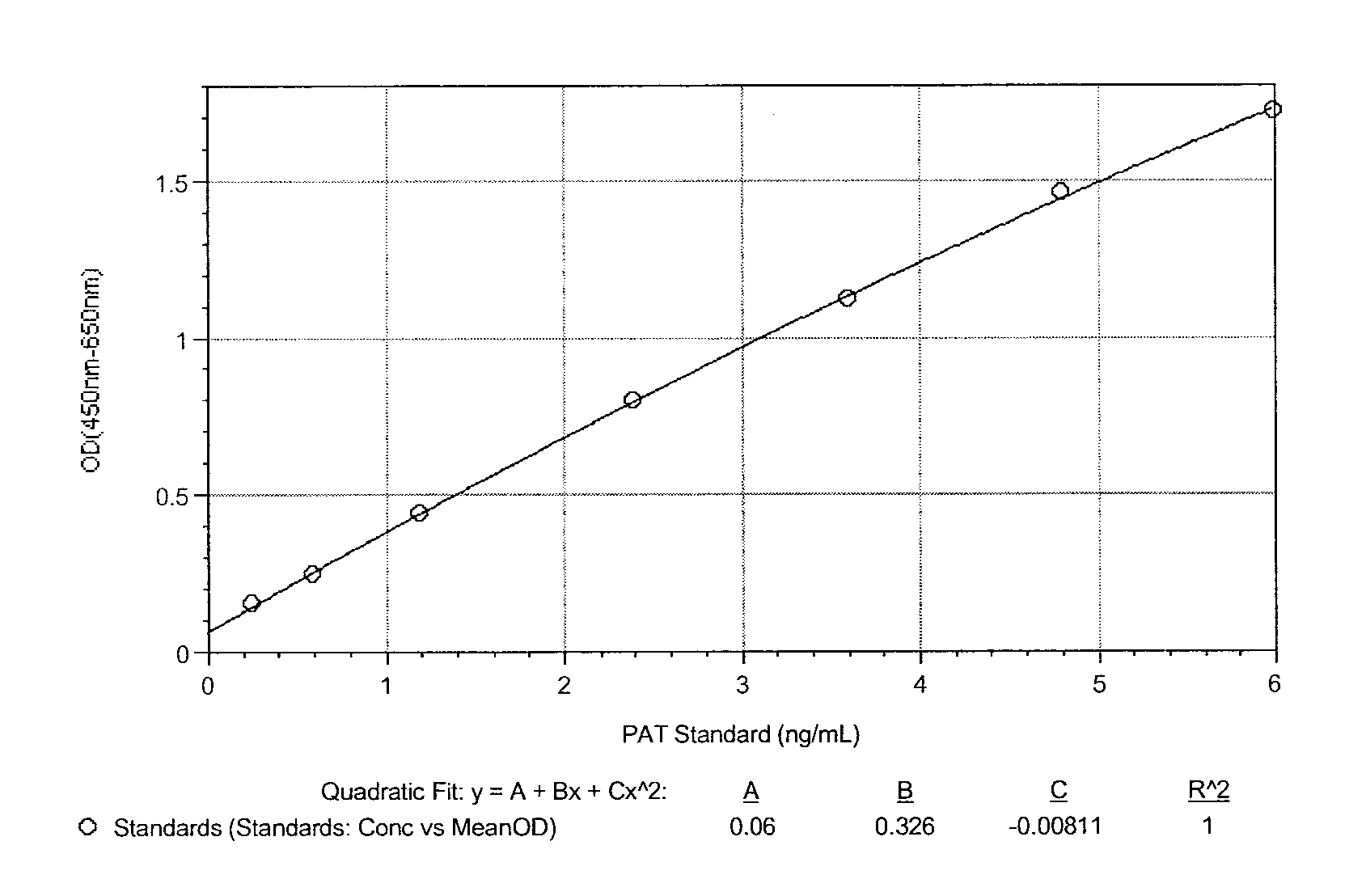Monoclonal antibodies and detection methods for phosphinothricin-N-acetyl-transferase enzyme
a technology of phosphinothricin and acetyltransferase, which is applied in the field of immunology, can solve the problems of not being able to develop robust, high-quality, validated elisa methods that are reproducibly able to detect a particular transgenic product in an array of plant tissue in both lab and field settings, and neither trivial nor routin
- Summary
- Abstract
- Description
- Claims
- Application Information
AI Technical Summary
Benefits of technology
Problems solved by technology
Method used
Image
Examples
example 1
Monoclonal Antibody Generation
[0033]Mice were immunized with purified recombinant PAT protein, and standard, PEG-mediated fusion techniques were used to prepare a panel of hybridomas expressing anti-PAT monoclonal antibodies. Samples of spent tissue culture media were removed aspetically from each well containing a hybridoma culture and assayed for PAT reactivity using the following antibody capture ELISA method. Microtiter wells were coated with a solution of 1-10 μg / mL of purified recombinant PAT protein. The wells were washed and samples of spent tissue media were placed in the wells and allowed to incubate. The wells were washed and horseradish peroxidase-labeled anti-mouse antibody was added and allowed to incubate. The plates were washed, substrate was added to develop a color reaction and the plates were read for optical density (OD). Wells with high OD readings were mapped back to culture wells containing the hybridomas. The PAT antibody positive cultures were continually sc...
example 2
Immunoblot Assay Development
[0034]Western blot conditions were evaluated and established for using either PAT monoclonal or polyclonal antibodies to detection PAT protein from transgenic crop tissue samples. The final assay used SDS-PAGE to separate samples and probed with PAT monoclonal or polyclonal antibodies after blotting to a membrane.
[0035]Leaf tissue samples from transgenic soybean expressing PAT were first extracted in a PBST buffer or directly in Laemmli buffer. Then heat-treated samples were subjected to SDS-PAGE. After the proteins were transferred to a PVDF or nitrocellulose membrane, the membrane was blocked in a blocking buffer and then incubated with either PAT monoclonal or polyclonal antibodies at room temperature for approximate 1 hour. After a washing step, the membrane was incubated with an HRP (horseradish peroxidase) conjugated, species-specific secondary antibody (e.g., for PAT monoclonal antibody, the secondary antibody was goat anti-mouse IgG antibody). Aft...
example 3
ELISA Assay Format and Development
[0036]Assay conditions were evaluated to determine the optimal antibody pair, antibody coating concentration, coating and blocking buffer constituents, coating format and pH, and antibody-HRP conjugation ratio and concentration. The final assay format used a sequential or simultaneous sandwich format constituting a polyclonal coating antibody and a monoclonal antibody-HRP conjugate.
[0037]In this system, PAT polyclonal antibody purified from antiserum lot D2976 was diluted in coating buffer and added to a microtiter plate. After incubation, the wells were blocked with blocking buffer and washed. Purified recombinant PAT protein samples were added to the coated reaction wells and incubated with HRP-conjugated monoclonal antibody 155Q12 for approximately 1 hour. After a washing step, a colorimetric substrate was added to the reaction wells. In the presence of PAT protein, PAT-specific monoclonal antibodies were bound in the reaction wells and the conju...
PUM
| Property | Measurement | Unit |
|---|---|---|
| concentrations | aaaaa | aaaaa |
| resistance | aaaaa | aaaaa |
| time | aaaaa | aaaaa |
Abstract
Description
Claims
Application Information
 Login to View More
Login to View More - R&D
- Intellectual Property
- Life Sciences
- Materials
- Tech Scout
- Unparalleled Data Quality
- Higher Quality Content
- 60% Fewer Hallucinations
Browse by: Latest US Patents, China's latest patents, Technical Efficacy Thesaurus, Application Domain, Technology Topic, Popular Technical Reports.
© 2025 PatSnap. All rights reserved.Legal|Privacy policy|Modern Slavery Act Transparency Statement|Sitemap|About US| Contact US: help@patsnap.com



